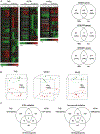Distinct signaling pathways after higher or lower doses of radiation in three closely related human lymphoblast cell lines
- PMID: 20005454
- PMCID: PMC7556731
- DOI: 10.1016/j.ijrobp.2009.08.015
Distinct signaling pathways after higher or lower doses of radiation in three closely related human lymphoblast cell lines
Abstract
Purpose: The tumor suppressor p53 plays an essential role in cellular responses to DNA damage caused by ionizing radiation; therefore, this study aims to further explore the role that p53 plays at different doses of radiation.
Materials and methods: The global cellular responses to higher-dose (10 Gy) and lower dose (iso-survival dose, i.e., the respective D0 levels) radiation were analyzed using microarrays in three human lymphoblast cell lines with different p53 status: TK6 (wild-type p53), NH32 (p53-null), and WTK1 (mutant p53). Total RNAs were extracted from cells harvested at 0, 1, 3, 6, 9, and 24 h after higher and lower dose radiation exposures. Template-based clustering, hierarchical clustering, and principle component analysis were applied to examine the transcriptional profiles.
Results: Differential expression profiles between 10 Gy and iso-survival radiation in cells with different p53 status were observed. Moreover, distinct gene expression patterns were exhibited among these three cells after 10 Gy radiation treatment, but similar transcriptional responses were observed in TK6 and NH32 cells treated with iso-survival radiation.
Conclusions: After 10 Gy radiation exposure, the p53 signaling pathway played an important role in TK6, whereas the NFkB signaling pathway appeared to replace the role of p53 in WTK1. In contrast, after iso-survival radiation treatment, E2F4 seemed to play a dominant role independent of p53 status. This study dissected the impacts of p53, NFkB and E2F4 in response to higher or lower doses of gamma-irradiation.
Conflict of interest statement
Conflict of interest: none.
Figures




Similar articles
-
Transcriptional responses to ionizing radiation reveal that p53R2 protects against radiation-induced mutagenesis in human lymphoblastoid cells.Oncogene. 2006 Jan 26;25(4):622-32. doi: 10.1038/sj.onc.1209082. Oncogene. 2006. PMID: 16247478
-
Expression level of miR-34a rather than P53 gene status correlates with mutability in related human lymphoblast cell lines.Mol Carcinog. 2012 Aug;51(8):674-7. doi: 10.1002/mc.20830. Epub 2011 Aug 1. Mol Carcinog. 2012. PMID: 21809390
-
Modulation of the DNA damage response in UV-exposed human lymphoblastoid cells through genetic-versus functional-inactivation of the p53 tumor suppressor.Carcinogenesis. 2002 Oct;23(10):1631-9. doi: 10.1093/carcin/23.10.1631. Carcinogenesis. 2002. PMID: 12376471
-
Radiation induced chromosome aberrations and clonogenic survival in human lymphoblastoid cell lines with different p53 status.Strahlenther Onkol. 1999 Jun;175(6):289-92. doi: 10.1007/BF02743582. Strahlenther Onkol. 1999. PMID: 10392171
-
Transcriptional modulation induced by ionizing radiation: p53 remains a central player.Mol Oncol. 2011 Aug;5(4):336-48. doi: 10.1016/j.molonc.2011.06.004. Epub 2011 Jul 7. Mol Oncol. 2011. PMID: 21795128 Free PMC article. Review.
Cited by
-
Ectopic expression of E3 ubiquitin-protein ligase 2 in glioma and enhances resistance to apoptosis through activating nuclear factor κ-light-chain-enhancer of B cells.Oncol Lett. 2018 Oct;16(4):4391-4399. doi: 10.3892/ol.2018.9153. Epub 2018 Jul 17. Oncol Lett. 2018. PMID: 30214574 Free PMC article.
-
Widespread decreased expression of immune function genes in human peripheral blood following radiation exposure.Radiat Res. 2013 Dec;180(6):575-83. doi: 10.1667/RR13343.1. Epub 2013 Oct 29. Radiat Res. 2013. PMID: 24168352 Free PMC article.
-
Lethal iron deprivation induced by non-neutralizing antibodies targeting transferrin receptor 1 in malignant B cells.Leuk Lymphoma. 2011 Nov;52(11):2169-78. doi: 10.3109/10428194.2011.596964. Epub 2011 Aug 28. Leuk Lymphoma. 2011. PMID: 21870996 Free PMC article.
-
RAD9 deficiency enhances radiation induced bystander DNA damage and transcriptomal response.Radiat Oncol. 2014 Sep 18;9:206. doi: 10.1186/1748-717X-9-206. Radiat Oncol. 2014. PMID: 25234738 Free PMC article.
-
Differential DNA methylation analysis of breast cancer reveals the impact of immune signaling in radiation therapy.Int J Cancer. 2014 Nov 1;135(9):2085-95. doi: 10.1002/ijc.28862. Epub 2014 Apr 5. Int J Cancer. 2014. PMID: 24658971 Free PMC article.
References
-
- Short SC, Buffa FM, Bourne S, et al. Dose- and time-dependent changes in gene expression in human glioma cells after low radiation doses. Radiat Res 2007;168:199–208. - PubMed
-
- Ding LH, Shingyoji M, Chen F, et al. Gene expression profiles of normal human fibroblasts after exposure to ionizing radiation: A comparative study of low and high doses. Radiat Res 2005;164:17–26. - PubMed
-
- Amundson SA, Bittner M, Meltzer P, et al. Induction of gene expression as a monitor of exposure to ionizing radiation. Radiat Res 2001;156:657–661. - PubMed
-
- Criswell T, Leskov K, Miyamoto S, et al. Transcription factors activated in mammalian cells after clinically relevant doses of ionizing radiation. Oncogene 2003;22:5813–5827. - PubMed
-
- Amundson SA, Lee RA, Koch-Paiz CA, et al. Differential responses of stress genes to low dose-rate gamma irradiation. Mol Cancer Res 2003;1:445–452. - PubMed
Publication types
MeSH terms
Substances
Grants and funding
LinkOut - more resources
Full Text Sources
Research Materials
Miscellaneous

